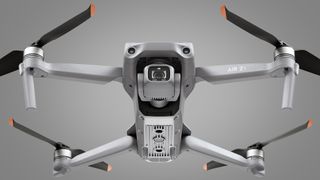This hidden DJI Air 2S trick explains why its raw photos look so good
Processing trick could divide opinion among photographers

We were so impressed with the DJI Air 2S when it came in for review, it garnered a rare five-star rating. But one slight oddity was the quality of its raw photos – quite simply, their performance at high ISO sensitivities was almost too good to be true.
Well, it turns that was indeed the case. After running our results past DJI and asking if the Air 2S applies any processing to its raw photos, it confirmed to us that "temporal denoising technology is used on the raw files".
What does that mean? In cameras, using higher ISOs is a double-edged sword – the extra light sensitivity allows you to get good exposures in gloomy conditions, but also usually adds noise to the photo.
The Air 2S' "temporal denoising technology", which isn't included in the drone's specs or features list, effectively reduces that noise in-camera to give you cleaner raw photos.
- These are the best drones you can buy right now
- Or check out our guide to the world's best beginner drones
- Read our in-depth DJI Air 2S review
On paper, that doesn't sound particularly controversial. For many owners, it might be seen as a benefit, as the DJI Air 2S' raw photos do look very good straight out of the camera.
But some photographers may not be entirely happy that the drone's raw photos are automatically processed. After all, the whole point of a raw file is that they're undeveloped digital images taken straight from your camera's sensor, hence the name.
This would be less of an issue if 'temporal denoising technology' was an optional feature that could be turned on or off in DJI's app. But when we asked DJI if the feature might become optional, it told us "there are no plans to offer this".
Get daily insight, inspiration and deals in your inbox
Get the hottest deals available in your inbox plus news, reviews, opinion, analysis and more from the TechRadar team.



Raw deal
The inclusion of automatic raw processing on the DJI Air 2S won't be a major issue (or even an issue) for most people. But it is something to be aware of, as some photographers may not be too happy with the lack of 'true' raw files from the drone.
If denoising processing was automatically applied to a mirrorless camera's raw files without an option to turn it off, that would likely be a controversial choice. And with drones like the DJI Air 2S now effectively flying versions of those ground-based cameras, they are now expected to offer a similar shooting experience (and be held to similar standards) as their mirrorless counterparts.
On the other hand, the feature does also reveals where the DJI Air 2S sits in DJI's lineup and who it's aimed at. While the Air 2S has a similar 1-inch sensor to the DJI Mavic 2 Pro (its higher-end compact drone), the 'Air' line is still DJI's mid-range offering for both hobbyists and pros looking for a small folding drone. And at that level, a small amount of automatic raw processing is likely far more acceptable for most fliers.
As the Air 2S has now almost made the DJI Mavic 2 Pro redundant (unless you need variable aperture), we're expecting to see a DJI Mavic 3 Pro (or perhaps DJI Pro 3) arrive later this year.
It's early days for rumors, but professional aerial photographers have been waiting for a successor to DJI's flagship compact drone for a while now – and you can get a feel for what the features we'll be looking for in our DJI Mavic 3 Pro: what we want to see feature.

Mark is TechRadar's Senior news editor. Having worked in tech journalism for a ludicrous 17 years, Mark is now attempting to break the world record for the number of camera bags hoarded by one person. He was previously Cameras Editor at both TechRadar and Trusted Reviews, Acting editor on Stuff.tv, as well as Features editor and Reviews editor on Stuff magazine. As a freelancer, he's contributed to titles including The Sunday Times, FourFourTwo and Arena. And in a former life, he also won The Daily Telegraph's Young Sportswriter of the Year. But that was before he discovered the strange joys of getting up at 4am for a photo shoot in London's Square Mile.